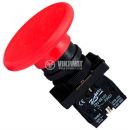















Electrical switches are an important part of electronics, electrical engineering both in industry and in everyday life. They allow us to control electrical devices and systems with ease and convenience. These switches are used in various spheres of life - from the domestic environment to industrial facilities. Switches are an indispensable component of any electrical appliance or in the construction of any electrical system.
One of the main aspects of electric push button switches is their functionality. In addition, electrical pushbutton switches are also important for the security of electrical systems. They are equipped with protection mechanisms that prevent overheating and short circuits. This ensures that electrical devices operate safely and reliably. The main application of switches is the control of electrical circuits, mainly ON-OFF functions for controlling machines and electrical appliances by controlling the respective switching on and off of the electrical supply to the electrical device.
Depending on the application and need, the switches are of different types such as push buttons, slide switches, panel switches, joystick type, rocker type, as well as foot switches, which gives different flexibility in different conditions and circumstances. The large range of types of switches provides prerequisites not only for the normal and safe operation of electrical devices and the control of the flow of electrocution. They have a variety of designs, contact systems and outputs, which helps to control and set the mode of operation of various light and heavy machines and devices both in industry and in the home, such as the control of ovens, boilers, coffee machines, sewing machines, light switches and other.
Pushbutton switches - are the most common switches in the control of electrical machines or devices. They are usually in the shape of a circle or a square and are controlled by pressing and have the option of being held or with a stable position.
Rocker type pushbutton switches - are a type of switches mainly for embedding in domestic or household appliances, as well as tools. Unlike standard push button switches, these "Rocker" type switches come in a variety of shapes and designs, with some even having a built-in light. They usually have functions to turn the power supply on and off and are labeled ON-OFF or 0-1.
Slide switches - are a type of switches for embedding in machines with a rectangular shape and the control of the contacts is carried out by means of a lever that moves in a channel. Unlike other switches, slide switches are more convenient to operate with gloves or in extreme conditions, and allow a different type of electrical signal output. They can be used both to turn machines on and off and to change the type of operation of machines.
Joystick type switches - electronic switches designed for manual control of electric circuits, by means of a contact system built into them. They play a key role in the management of various types of machinery and equipment. They provide operators with the ability to control machine movements and functions in an efficient and safe manner. They are controlled by a lever that moves in different directions and depending on this controls a different number of contacts by positioning it in different directions. They are retaining and non-retaining.
Package switches - are electric switches with multi-pole sections and contacts, which gives an extended possibility to control different types of devices, machines and equipment. They are usually in the form of a handle that moves in circular motions and depending on its position gives different control to the electrical circuits, and the fact that many sections are composed makes it possible to control not only the power supply, but the degree or type of operation. They are suitable for stoves, ovens, fans and machines with different degrees of operation.
Engine starters - are devices for starting and controlling asynchronous electric motors (electric motors) or other electrical consumers. They offer different starting methods such as direct starting, voltage controlled starting (soft start) or frequency controlled starting. This allows users to choose the most suitable method for their needs and control the start of the electric motors according to the specific operating conditions.